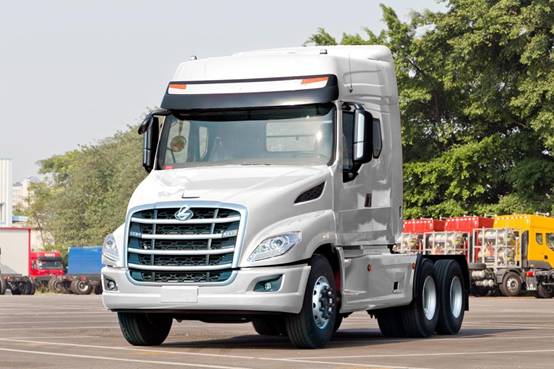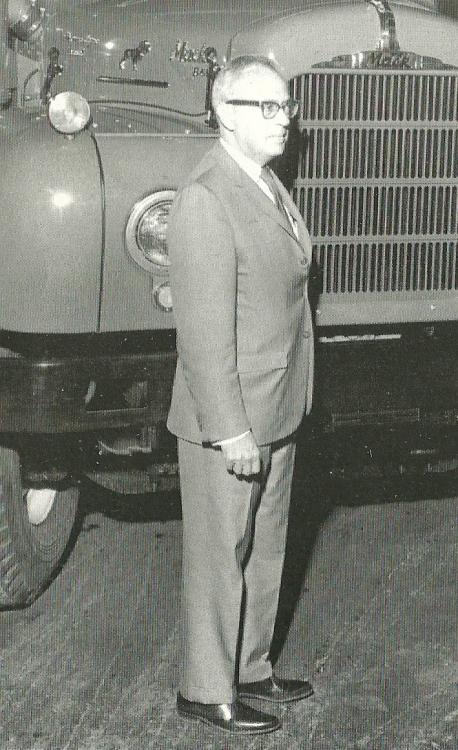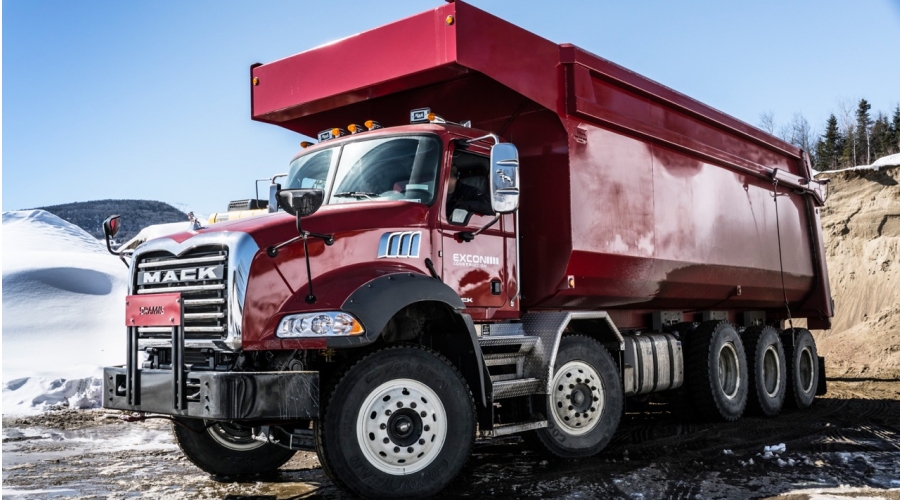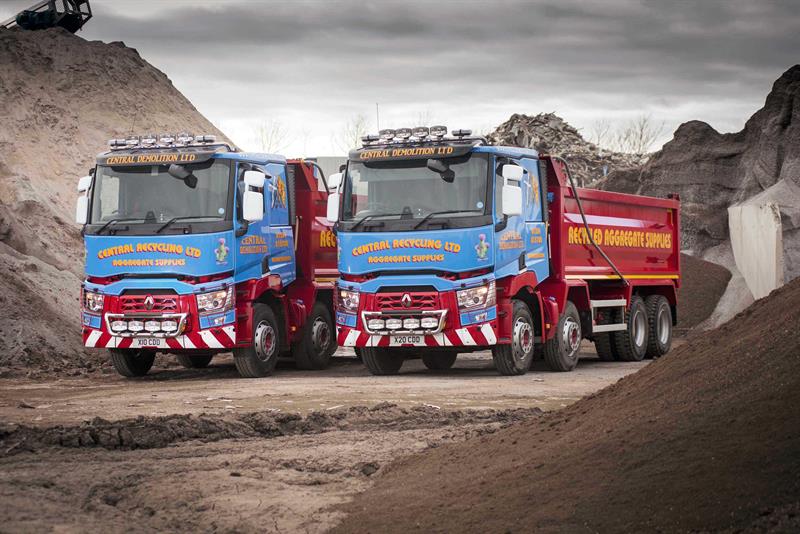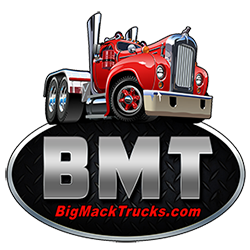
kscarbel2
Moderator-
Posts
18,882 -
Joined
-
Days Won
114
Content Type
Profiles
Forums
Gallery
Events
Blogs
BMT Wiki
Collections
Store
Everything posted by kscarbel2
-
Truck 360 / March 14, 2016 With the overall legal length of conventional cab (bonneted) tractor-trailers in the world’s largest heavy truck market set to increase to 18.1 meters (59.4 feet), the viability of short-nosed conventional cab tractors is now at hand. Changes to the country’s GB1589-2012 dimension and weight regulations will allow an additional one meter (39.4 inches) in tractor length. Dongfeng Group’s Liuzhou truck division, unrelated to Volvo's joint venture with Dongfeng’s Shiyan truck division (Dongfeng Commercial Vehicle), is the first player to take the stage with a modern conventional cab design. Dubbed the T7, it is powered by either the 13-liter Cummins ISZ rated from 450 to 550 horsepower, or other high power options from Chinese engine makers Weichai and Yuchai. Manual and AMT transmission options include Eaton, ZF and Fast Gear. .
-
Government takes stand in minimum payment debate
kscarbel2 replied to kscarbel2's topic in Trucking News
ATA to host anti-RSRT Canberra convoy Owner/Driver / April 14, 2016 Convoy will arrive at the Parliament lawns on Monday and hear from ministers and senators The Australian Trucking Association (ATA) has organised a convoy to Canberra to rally the disenfranchised owner-drivers in a show of force against the Road Safety Remuneration Tribunal (RSRT) and its Contractor Driver Minimum Payments Road Safety Remuneration Order 2016 (RSRO). Scheduled around a convergence on the Parliament House lawns at 7am on Monday, April 18, the ATA’s Canberra Anti-RSRT Convoy will feature a number of ministers and senators speaking to the assembled crowd. Asking its members to register for the event, the trucking body says it has also organised accommodation for the Sunday night. "The ATA has organised free and secure camping and the use of facilities at Exhibition Park in Canberra (EPIC)," the industry body says. "EPIC’s Burrawang Café will be open Sunday from lunch and including through dinner. "Free breakfast on Monday is being provided by the ATA from 5.00am." With Parliament to sit from 9:30am, the ATA plans to organise the drivers to head into event from 6am. Further details, and registration, are available here. -
Owner/Driver / April 14, 2016 As his father inspired his love of trucks, David Grima has spawned a love of Kenworth trucks in his own children through his show-winning T401 Like many blokes, David Grima grew up in a trucking family. His father Angelo drove trucks, and as his brothers Laurie and Joey left school, they bought trucks and got into earthmoving. "I thought I would follow suit, so the three of us worked together," David says. "We each had our own gear but would work together to help each other out." After years in earthmoving and then behind the wheel of a FL80 Freightliner, David began a search for a truck "with a bit more power and a sleeper." After months of searching a 2007 model T401 with under 200,000km on the clock became available, and David didn’t hesitate. Little did he know at the time that this Kenworth was going to win Rig of the Show at the 2014 Penrith Museum of Fire truck show. "Finally after 20 years, we won Rig of the Show," David grins. "I was going to give it a miss". "The win was a huge shock." "Everyone said that I was mad to buy a bonneted truck again but I like the bonneted rigs. I’m not a cab-over fan," he says. "We built the tray ourselves and went mad with stainless steel. "I have a good friend, Jonny Camilleri, and he helped with all of the stainless work. I wanted something totally different to everyone else." While David wanted to remain with a 6x4, the Kenworth has a Cat C12 in it, and with the IT sleeper, bigger diffs and bigger gearbox, the truck is heavy. David spoke to G&O Industries at Blacktown and was suggested they put another axle under it. While making it into a completely different truck, the change has also upped the weight that it can carry by an additional two tonnes. He could then be more versatile, and when carrying small machines, the axle can be raised. David is happy with the IT sleeper. Being a small bloke, he finds it ideal. He also fit a TV in. His kids can use the bunk and are happy to share the ride. "It has been a big job but I am very proud of my truck," he says. "And I hope it shows!" See the full story in the April 2016 issue of Owner//Driver magazine. Photo gallery - http://www.ownerdriver.com.au/truck-reviews/1604/utom-grimas-show-winning-kenworth-t401/
-
Daily Mail Australia / April 13, 2016 A father has written a touching letter to their 'rubbish truck guy' thanking him for being his two-year-old son's hero. Aaron Brown took to Facebook to thank the mystery truck driver from Tuakau in New Zealand who has smiled and waved to his son Alex every Tuesday for the past two years. The father of one admitted that he never took any notice of the rubbish collector and just expected the trash to be picked up every week, but that changed when his son was born. 'All of a sudden it was a highlight for us. Every Tuesday morning we hear your big truck coming and the excitement begins,' Mr Brown wrote. 'Even before he could walk or talk our son would stop what he was doing and make his way to the front door. 'I would take him out side and he would look on in amazement as you expertly guided your (ACCO) truck around the cul de sac and picked up each bin with what has become known as your crocodile arm.' He said while the mystery driver could just carry on and ignore them, he always waves and says 'hi boy' with a big smile. 'It took Alex about a year but then the day he waved back you were so happy and it made Alex laugh. Now every Tuesday morning, Alex runs to the door and leads me out so he can watch and wave at you and as always, you wave back with a huge smile,' he said. Mr Brown said the rubbish collector out did himself this week outside Alex's daycare when the toddler didn't want to get out of the car. 'Then he heard your truck. He instantly wanted out so he could see you. As you drove past you recognised us. You didn't have to, but you did. Again a huge smile and wave. Alex waved back and was so excited to go into daycare and tell everyone about you,' he said. The Facebook post has been liked and shared thousands of times after it was posted on Tuesday. .
-
Assisted by fellow Mack engineer 'Win' Pelizzoni, Walter May invented Mack Trucks' revolutionary Maxidyne/Maxitorque high-torque-rise powertrain concept that literally turned the whole truck industry on end. Unlike conventional diesel truck engines, the game-changing Maxidyne had the ability to increase the fuel charge and air supply when the engine speed was decreasing. And likewise, as the engine speed increased up the rpm range, the air supplied and fuel injected decreased. This combination of abilities resulted in the global truck industry's first constant-horsepower engine. Walter May designed the legendary and indestructible Mack triple countershaft Maxitorque transmission to complete the powertrain, itself revolutionary for its simple 5-speed design, high torque rating, compact size, and lightweight heat-dissipating aluminum case. Walter May's list of Mack patents would fill a book. Head engineer and COO of Mack Trucks, he was a genius in heavy truck design.....literally. Related reading - http://www.bigmacktrucks.com/topic/30184-all-eyes-are-on-the-new-maxidyne/#comment-167898
-
March 30, 2015 I was deeply saddened to learn of Walter's passing. He was a big supporter of our efforts at Mack International and he and Hazel frequently entertained our major overseas distributors in their home. The world was a far better place with them in it. Hagen McGuire, Macungie, PA (Former Manager International Accounts & Sales Engineering, Mack Trucks Inc.)
-
April 6, 2015 I was deeply saddened to hear of Walter May's passing. I had the honor of passing by Walter in the halls at Mack and the Tech Center, and will remember him as the father of the Maxidyne. Frank Bio (former Mack Trucks engineer)
-
March 31, 2015 A associate for many years, he helped Mack remain the "The greatest name in trucks"! Learned a great deal from him and he was a industry Icon! Jack and Rosemary Curcio
-
Walter M. May, 97, Mack Trucks Engineer and co-inventor of the truckmaker’s advanced Maxidyne high-torque rise engine technology Walter M. May, age 97, of Luther Crest Retirement Community, South Whitehall Township, formerly of Harris York, Macungie, died March 27, 2015, at home. He was the husband of the late A. Hazel May. Walter worked as an engineer and C.O.O. at Mack Trucks, retiring as Vice President of the Engineering Department. He held many engine and transmission patents that are still used in truck manufacturing 60 years later. Born in New York City, he was the son of the late Walter H. and Janet (Forbes) May. He was a 1939 graduate of M.I.T. Like his former colleague Zenon C.R. Hansen, Walter was an Eagle Scout. During World War Two, he worked for the Civil Defense Department. He and his wife Hazel were benefactors at M.I.T., Cedar Crest College and Lehigh Valley Medical Center. Survivors: Daughter: Susan wife of Paul Trexler of Seminole, FL., Step-Sons: Malcolm W. Heckman and his wife Joanne of Galloway Twp., NJ and Ronald B. Heckman and his wife Pamela of Emmaus, Fiancée: Carol R. Cook of Topton, 10 Grandchildren, 20 Great-Grandchildren and 1 Great-Great-Grandchild. .
-
The Mack family once again remembers legendary chief engineer and vice president, Alfred Fellows Masury.
-
Do you have an E6-350 2-valve or 4-valve ? (We still built both in 1985) I'm a sales guy, but the legendary Mack parts numbering system having been as brilliantly straightforward and simple as it was, I vaguely recall: 62GB2382 P1 (standard size) for E6-350 2VH 62GB2393P1 (standard size) for E6-350 4VH These are the part numbers for a set. The actual stamped part number is for a bearing half, which you never could buy separately. Your Mack parts representative can supercede the stamped number on the rod bearing half to the set part number. You stated 62GB312 (the other half being 62GB313).......that's a 62GB2393......a rod bearing for a 4VH E6-350. Main bearing sets didn't change, so a 215SB72DP1 kit (standard size). If you need oversize, the "P" variation will be different. And if need be, source your rod and main bearings from the good folks at Watts Mack. I thank legendary Mack Trucks chief engineer and vice president Alfred Fellows Masury for creating the best parts numbering system that the global truck industry ever knew. I pity the Mack parts people today who are bogged down with meaningless Volvo global part numbers you can't remember.
-
European Parliament Plenary Session Press Release / April 13, 2016 A proposal to grant €1,793,710 (US$2.02 million) in European Union (EU) aid to Sweden to help find new jobs for 500 workers made redundant by Volvo Trucks, mainly at the Umeå plant, and by four of its suppliers and downstream producers, was approved by the European Parliament on Wednesday. The employees were laid off due to difficulties faced in recent years by European manufacturers in competing with newly emerging Asian truck manufacturers. Heavy truck production in the EU fell in 2014, as did exports of heavy commercial vehicles, buses and coaches, while overall imports of commercial vehicles into the EU rose. Volvo therefore decided to boost efficiency by cutting costs to meet existing and expected global competition. The redundancies are a challenge for Västerbotten county (of which Umeå is the capital). Most of the redundant Volvo workers are from Umeå, but others from Gothenburg and Eskilstuna are also included in the scheme. Volvo's optimisation programme also affected subcontractors, especially in Umeå. The resolution by rapporteur Victor Negrescu (S&D, RO) was approved by 585 votes to 82, with 7 abstentions. Background The European Globalisation Adjustment Fund contributes to packages of tailor-made services to help redundant workers find new jobs. Its annual ceiling is €150 million. Redundant workers are offered measures such as support for business start-ups, job-search assistance, occupational guidance and various kinds of training. In most cases, national authorities have already started the measures and will have their costs reimbursed by the EU when their applications are finally approved. Related reading: http://www.bigmacktrucks.com/topic/44047-european-commission-proposes-almost-18-million-euro-from-globalisation-fund-to-support-former-volvo-trucks-workers-in-sweden/#comment-324651 http://www.bigmacktrucks.com/topic/33165-volvo-to-restructure-truck-manufacturing-in-europe/#comment-212024
-
Simard Suspensions Press Release / April 6, 2016 After 5 years of development, thousands of test hours in extreme conditions, the industry unique off-road truck able to legally roll on the road, the Dramis D55T truck, is on its way to the Chilean salt mines. A total of 7 trucks will join the Excon Construcciòn fleet, one of the biggest ore transportation companies in South America. "With a payload of 55 metrics tons (60 imperial ton), twice the capacity of actual trucks, Excon Construcciòn will be able to greatly increase its production," explains Denys Dufour Simard Suspensions Sales Manager. Industry unique specifications The Dramis benefits of a superior payload and also operates faster. With its active hydraulic suspension and adapted gear ratio, it is able to circulate up to 90km/h, giving it the capacity to do more cycles than articulated or rigid trucks. The cost per ton of the Dramis D55T is the most profitable of its category. Built on a class 8 vocational truck chassis, its purchase price is less than its competition, and its maintenance does not require a specialized technician. Its fuel consumption cost is between 15 and 20l/hour depending on the configuration. Another decisive advantage, the Dramis can circulate unloaded legally on road that offers the opportunity to move from site to site without requiring a trailer or special permits. “I thank Excon Construcciòn and its team for the support given to us all along this project as well as all those who participated in its development,” says David Tremblay, Simard Suspensions Chief Executive Officer. Custom configuration Totally assembled in Québec, Canada, the Dramis is available in many configurations and adaptable on all vocational commercial trucks in North America such as Mack/Volvo, Kenworth/Peterbilt, Freightliner/Western Star, and soon to be the new International HX. Simard Suspensions 100% Canadian Company, Simard Suspensions (http://simardsuspensions.com/) is established in the Quebec since 1935. Employing 110 persons, Simard stands out with its tandem suspensions distributed in all North America and South America. Simard Suspensions is always hiring to meet new orders and with the ongoing need for labor a training program in partnership with Formation Continue Charlevoix has been implemented. .
-
U.S. Medium and Heavy Truck Sales Down 10% in March
kscarbel2 replied to kscarbel2's topic in Trucking News
Canada Big Truck Sales Down 26.7% in March Wards Auto / April 13, 2016 Big-truck deliveries in Canada were down 26.7% on a daily sales basis in March with 3,275 units, compared with 4,294 from prior-year. Sales in Class 8 fell 36.1% to 1,915 units. All manufacturers posted double-digit losses. Share leader Freightliner sales declined 26.1% on 752 units while still increasing share to 39.3%. The worst performers were Volvo, down 62.6%, and Kenworth, 44.9% below prior-year. Western Star showed the smallest drop at 19.6%. -
Wards Auto / April 13, 2016 Sales of medium and heavy trucks in the U.S. totaled 40,323 in March, 2.5% below year-ago on a daily sales basis. Class 8 posted sales of 20,034 units, down 10.1% from prior-year. Substantial losses by International (-29.1%), Peterbilt (-22.8%) and Volvo (-52.7%) led the decliners. Daimler’s Freightliner and Western Star outsold last year, leaving the parent company up 16.5%. Mack posted a small gain, growing 1.3%. Year-to-date, Class 8 sales were down 7.1%.
-
Two Renault Range C trucks have joined the 30-stron g fleet of Scottish demolition, asbestos removal and recycling specialist Central Demolition. The company’s first from the Renault Trucks stable, both 32-tonners are C430 RKs with Optidriver AT 2612E AMTs (automated manual gearboxes), have been specified with the night and day cab. They have been mounted with Weightlifter Muckaweigh hardox tipping bodies, and equipped with Kelsa top and bottom light bars, comfort seats, Renault’s comfort pack and vertical exhausts. “When we needed additional, new vehicles to keep up with the demand I turned to the team at Renault Trucks Scotland who put together an impressive package,” comments Central Demolition owner Ross Craig. “We’ve previously used Renault Landers and have been extremely impressed by their robustness and overall performance, so the Range C was the natural progression for us,” he continues. “Access in and out of demolition and recycling sites can be tricky, so we needed tippers with exceptional mobility... “We’ve found the Range C to be well up to the challenge... It’s a well-constructed vehicle, very well accepted by our drivers and provides good value-for-money overall.” The new 32-tonners were supplied by Renault Trucks Scotland. .
BigMackTrucks.com
BigMackTrucks.com is a support forum for antique, classic and modern Mack Trucks! The forum is owned and maintained by Watt's Truck Center, Inc. an independent, full service Mack dealer. The forums are not affiliated with Mack Trucks, Inc.
Our Vendors and Advertisers
Thank you for your support!


